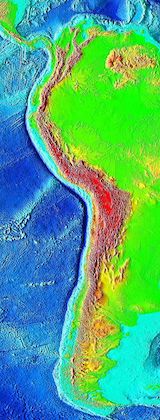deep edge.jpg

The Peru-Chile Trench. Photo Credit: Public Domain
The Pacific coast of South America is a bit like a medieval castle surrounded by a moat. The “castle” is the Andes Mountains, which hug the coast. And the “moat” is the Peru-Chile Trench -- a gash in the ocean floor that’s miles deep.
Castle and moat were built by the motions of two of the plates that make up Earth’s crust. The Nazca Plate, which makes up part of the floor of the Pacific Ocean, is sliding under the South American Plate, which makes up most of the continent.
The Peru-Chile Trench marks the boundary between the two -- the zone where the Nazca Plate disappears. The trench is about 3700 miles long and averages about 40 miles wide. Its deepest spot, known as Richards Deep, bottoms out at a depth of more than five miles.
The motions of the two plates are a bit herky-jerky. As Nazca slides eastward at a couple of inches per year, it scrunches up the edge of South America, forming the Andes. It also scrunches up sediments in the trench, “cementing” them to the edge of the South American Plate.
The Nazca Plate sometimes sticks a bit, then releases with a massive jolt. That creates powerful earthquakes. In fact, the strongest quake ever recorded, in 1960, was centered along the Peru-Chile Trench.
That quake caused massive damage in Chile. It also created a tsunami that raced across the Pacific Ocean. It killed hundreds in Chile, and hundreds more elsewhere -- destruction caused by the continued building of South America’s moat and castle.

